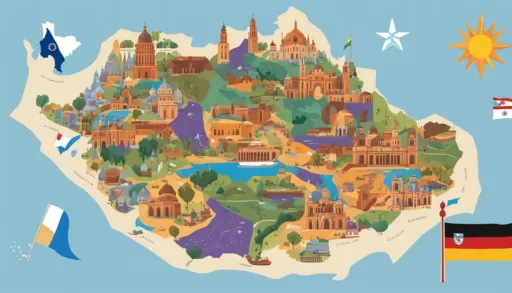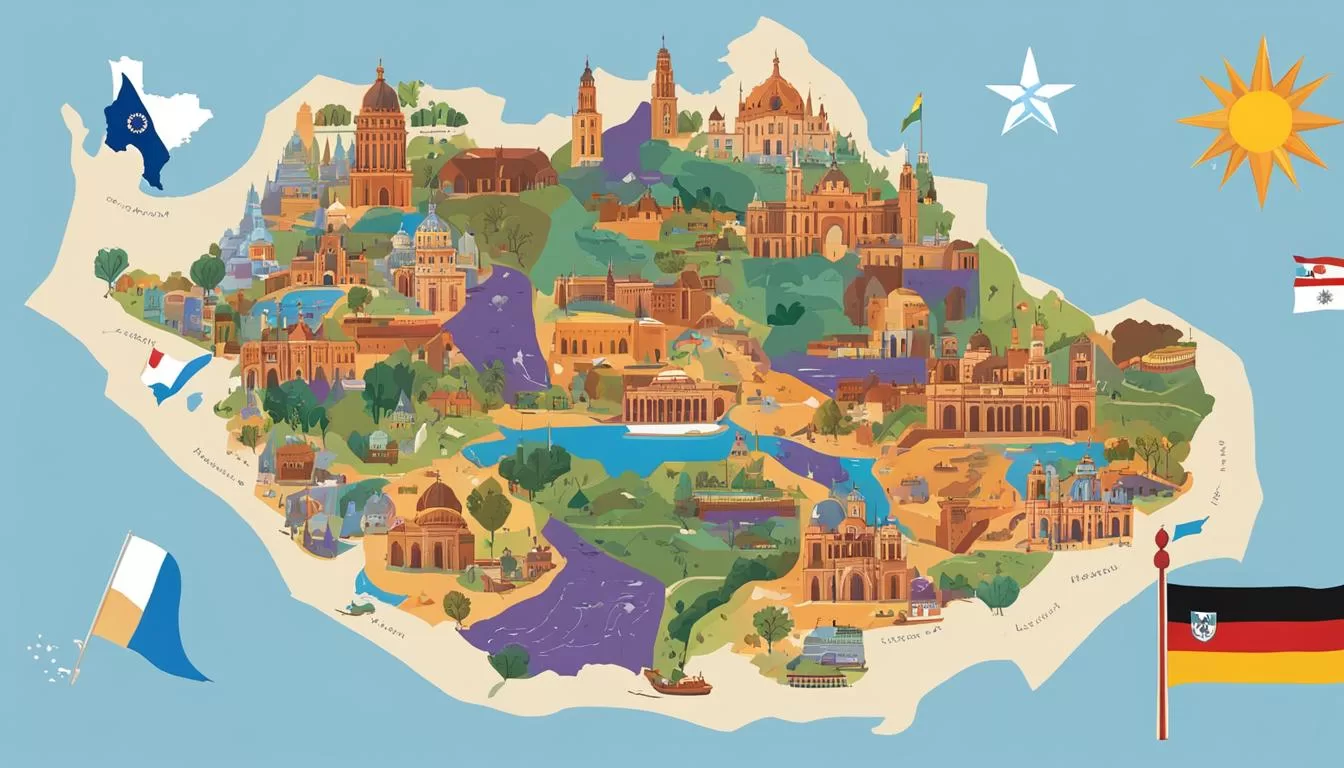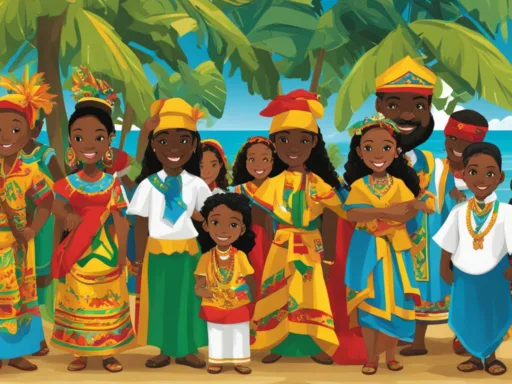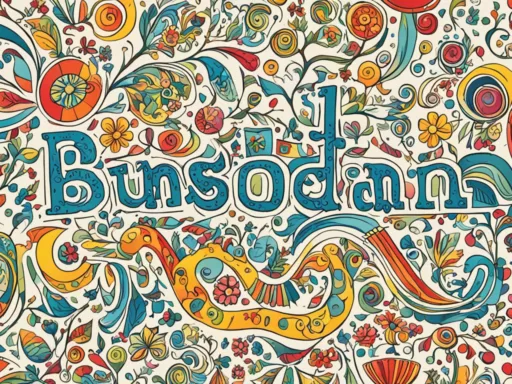With a blend of sounds and syntaxes breathing life into its streets and countrysides, Argentina’s linguistic landscape is a mosaic as vibrant as its people. The country’s spoken words paint a picture of historical journeys, cultural exchanges, and a society rich in diversity. **Languages spoken in Argentina** are not confined to the borders of its official language, Spanish, but extend to a colorful array of indigenous tongues and immigrant dialects, shaping a unique Argentine ethos.
While **Spanish Argentina** remains the pervasive language, seamlessly uniting the nation of over 45 million souls, the resonance of **indigenous languages Argentina** is heard across the plains and mountains. These languages weave together the historical threads that have been spun since time immemorial through the lips of the Mapuche, Guarani, and Quechua peoples, among others. As we delve into the intricate web of Argentina’s spoken heritage, we uncover stories told in countless dialects, each contributing to the nation’s rich oral tapestry.
Key Takeaways
- Spanish is the most widely spoken and de facto official language of Argentina.
- The rich mosaic of languages includes a significant number of indigenous dialects like Quechua and Guarani.
- English is gaining importance with mandatory education policies and high proficiency rankings.
- Immigrant languages such as Italian and German enhance the cultural and linguistic diversity.
- Unique linguistic phenomena like Lunfardo and Portuñol reflect Argentina’s complex societal blend.
- Despite its linguistic variety, Argentina is unified through a common understanding of Spanish.
The Predominance of Spanish in Argentina
In the heart of South America, the linguistic fabric of Argentina is dominated by the flowing rhythms and unique expressions of Spanish. Among the many Spanish dialects painting the country’s linguistic canvas, Rioplatense Spanish stands out as the distinctive voice ringing through the Río de la Plata basin. This dialect, with its melodious intonation and particular lexicon, is a unifying force for the majority of the country’s population.
Rioplatense Spanish and its Variants
The prevalence of Rioplatense Spanish extends beyond Buenos Aires, reaching the ears of approximately 19 million speakers across Argentina. Its variants, such as the Litoraleño dialect, echo through the provinces of Santa Fe and Entre Ríos, resonating with a charm exclusive to the eastern riverbanks. Venturing inland, Cordoba Spanish captivates with its own cadence, a cornerstone of identity for nearly 3.75 million speakers within the provinces of Córdoba and San Luis.
From the bustling cities to the tranquil pampas, the strains of Rioplatense Spanish and its vibrant dialects craft the story of a nation deeply connected by language.
Below we can observe the distribution of Spanish dialect speakers across key regions in Argentina:
| Dialect | Region | Estimated Speakers |
|---|---|---|
| Rioplatense Spanish | Buenos Aires, Río de la Plata basin | 19 million |
| Litoraleño dialect | Santa Fe, Entre Ríos | 5 million |
| Cordoba Spanish | Córdoba, San Luis | 3.75 million |
Legal Status of Spanish as the De Facto Official Language
Spanish, the de facto official language of Argentina, casts its influence broadly across the administrative and educational spectrums of the nation. Though not legally enshrined, Spanish is deeply rooted in the Argentine constitution, guiding local jurisprudence and national enlightenment. It remains the cornerstone upon which societal interaction and governance are built, a true testament to its undoubted hegemony in this diverse country.
While Argentina’s dance with language is complex, the dominance of Spanish as the central forum for expression provides a shared voice for its people. This shared voice is rich with the tones and turns of Rioplatense Spanish, the Litoraleño dialect, and Cordoba Spanish—variations on a theme that continue to shape the nation’s vibrant communications.
Languages Spoken in Argentina: An Overview of Indigenous Tongues
Amidst the linguistic diversity that defines the nation, the indigenous languages of Argentina offer a compelling glimpse into the country’s rich cultural heritage. The voices of the past resonate in the present, as these ancestral tongues continue to be spoken by communities that retain a deep connection to their history and traditions. In particular, the Guarani and Quechua speakers stand as custodians of languages that have echoed through the hills and valleys of this region for centuries.

Guarani and Quechua: Lingering Voices of the Past
With approximately 200,000 speakers, Guarani is one of the most prevalent indigenous languages in Argentina, signifying a vital part of the nation’s verbal landscape. Alongside it, Quechua resonates with about 65,000 individuals, reflecting the enduring legacy of Inca influence well beyond the borders of Peru. These languages, with their unique sounds and structures, offer an enduring connection to pre-colonial times.
The Dwindling Speakers of Indigenous Languages
While Guarani and Quechua are prominent, they represent just a fraction of the 15 indigenous languages that are actively spoken in Argentina today. Many of these languages are sadly teetering on the brink of extinction, with only a handful of speakers preserving them for future generations. Their decline speaks to the wider challenge of maintaining linguistic diversity in an ever-globalizing world. This challenge underscores the importance of linguistic preservation and the role it plays in safeguarding cultural identity and diversity within Argentina.
English Proficiency in Argentina: A Surprising Aptitude
As the world grows ever more interconnected, the ability to communicate across cultures becomes increasingly critical. In the land of the tango and wide pampas, Argentina demonstrates a commitment to this global conversation with its remarkable embrace of English Argentina. The nation’s proficiency in English not only connects Argentines to the wider world but also reflects a progressive approach to language education that fosters international opportunities.
The Role of English in Education
Argentina’s strategic approach to language learning is exemplified within its educational system. English education Argentina is not merely an elective in academic curricula; it has evolved into a compulsory subject. From bustling Buenos Aires to serene Patagonia, it is mandatory for primary school students in several provinces to dive into the nuances of English, laying a foundation for bilingual proficiency that reverberates through their futures. This emphasis on English literature, grammar, and conversation in schools underscores the value placed on bilingual education, grooming students for global citizenship.
Argentina’s Global Ranking in English Proficiency
Argentine English proficiency has garnered attention on the international stage, further shining a light on the country’s linguistic achievements. The English Aptitude Index painted a compelling picture of Argentina’s capabilities when it ranked the country 15th globally in 2015, a testament to the investment in English education. Though Argentina witnessed a dip to the 25th spot by 2017, it maintained its position as the second highest-ranked Ibero-American nation, trailing just behind Portugal in the realm of English mastery.
The data below illustrates Argentina’s standing in English proficiency over recent years:
| Year | Global English Proficiency Rank | Ibero-American Ranking |
|---|---|---|
| 2015 | 15th | 1st (Latin America) |
| 2017 | 25th | 2nd (After Portugal) |
This robust approach to English education Argentina sets the stage not only for individual advancement but also for enriching the country’s cultural landscape. As Argentina continues to prioritize English proficiency, the potential for its residents to participate in and contribute to global dialogues only swells, promising a future where Argentine voices are heard and valued in a multiplicity of tongues across the globe.
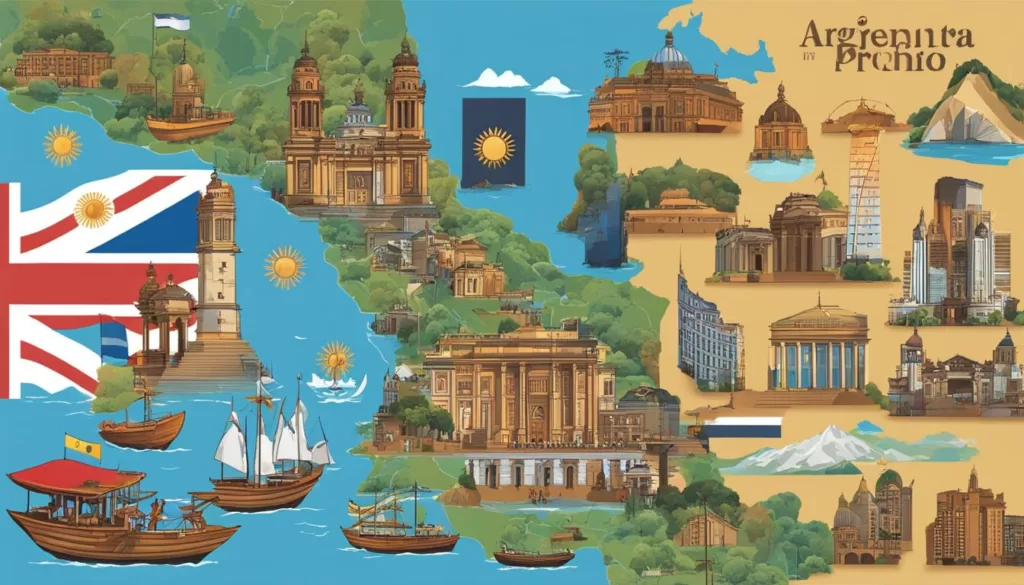
European Languages and Immigration: A Historical Legacy
The cultural and linguistic contours of Argentina have been indelibly shaped by waves of European immigration, leaving an eclectic tapestry of languages that resonate throughout the nation. From the late 19th century to the present, the influx of Europeans has introduced a multiplicity of tongues, each contributing its unique hue to the Argentine linguistic mosaic. Above all, the influence of Italian and German immigrants stands prominent, recasting the local parlance with their distinct European flavor.
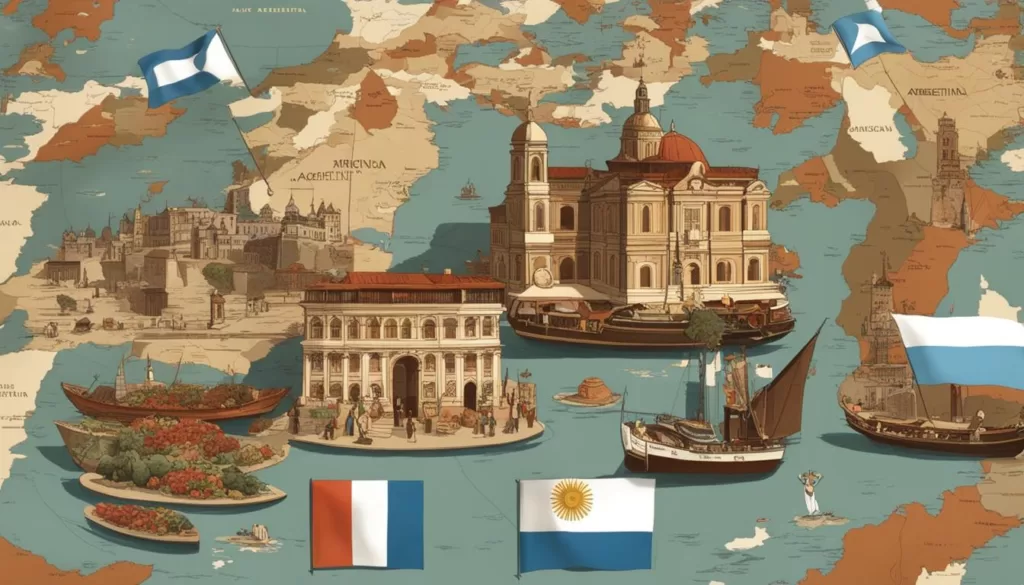
Italian and German Influence in Argentine Linguistics
The sound of Italian Argentina speaks volumes of the profound connection between Italy and this South American country. With a melody evocative of the Italian Peninsula, languages such as Piedmontese and Ligurian have been woven into Argentina’s societal fabric, influencing the local vernacular since the 1880s. This Italian heritage pulsates strongly within the linguistic rhythm of communities, particularly in Buenos Aires, where echoes of Italia enrich everyday conversation.
Concurrently, German Argentina has cast its resonance through communities of immigrants and their descendants. With approximately 200,000 individuals speaking various German dialects, including the Mennonites’ Plautdietsch, Argentina’s linguistic landschaft bears the unmistakable imprint of Germanic cultures. This presence adds a layer of diversity to local dialects, contributing to the rich tapestry of Argentine spoken word.
Lesser-Known European Languages in Argentina
Beyond the predominant Italian and German, Argentina is home to a kaleidoscope of European languages brought by immigrants who sought new horizons. Extending from Albanian to Welsh, and even the whispered cadences of Yiddish, these languages persist within ethnic enclaves, predominantly preserved within family circles and communal gatherings. Although their public prevalence might be muted, the legacy of European languages immigration Argentina endures, articulating the complex tapestry of this nation’s identity.
Below is an overview of the European languages spoken in Argentina and their respective community sizes:
| European Language | Community Size |
|---|---|
| Italian | Significant Influence |
| German | Approx. 200,000 speakers |
| Welsh | Communities within Patagonia |
| Yiddish | Conserved in Jewish Communities |
| Other European Languages | Various Family Circles |
The enduring presence of these European languages, whether pronounced or subtle, is an acknowledgment of Argentina’s rich immigrant narrative, a tale that has been told and retold through generations in a multitude of accents and idioms.
Assimilation of Languages: The Case of Lunfardo and Portuñol
The linguistic panorama of Argentina is characterized by a fascinating melting pot of cultural expressions, and nowhere is this more evident than in the emergence of Lunfardo and Portuñol. These rich forms of Argentine slang illustrate the fluid nature of language and the influence of immigration and border proximity in shaping the way people communicate.
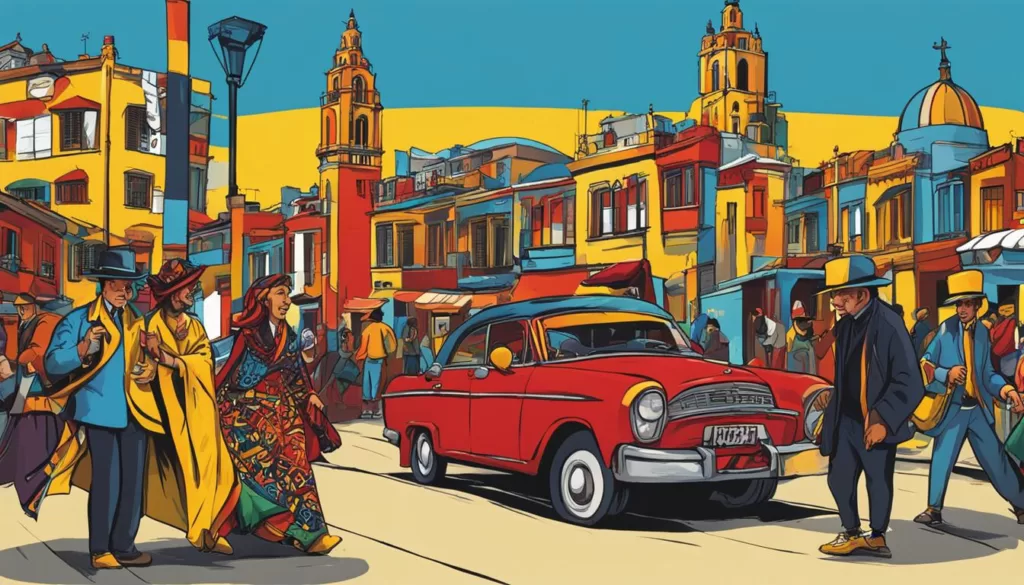
Exploring the crevices of Argentina’s streets and the melody of its speech, one can hear the fascinating twists and turns of language as it bends and blends into new forms. Lunfardo and Portuñol stand as vivid testaments to the adaptability and creativity inherent in human communication, giving voice to the country’s unique cultural identity.
Lunfardo: A Unique Argentine Slang
Originating in the cosmopolitan hub of the Río de la Plata, Lunfardo began as the jargon of the underclass but quickly spread across all social layers. With its roots tangled in the diverse linguistic threads brought by immigrants, Lunfardo has assimilated words from Italian, Portuguese, and other languages, infusing the Argentine Spanish with an exotic flavor. It serves not only as a means of communication but also as a cultural marker that symbolizes the heterogeneous nature of Argentine identity.
Portuñol: A Cultural Blend along the Brazilian Border
Along the porous edges where Argentina and Brazil meet, a linguistic phenomenon known as Portuñol has flourished. This fascinating hybrid of Portuguese and Spanish is less a formal language and more a spontaneous concoction of communication, born of necessity and neighborly influences. Since the 1960s, Portuñol has evolved into a vibrant language of its own, enabling cross-cultural interaction and signifying the friendly rapport between the bordering residents.
A closer look at each reveals the intricate patterns that languages weave when they cross paths:
| Linguistic Feature | Lunfardo | Portuñol |
|---|---|---|
| Origin | Río de la Plata region | Brazilian border areas |
| Components | Spanish, Italian, Portuguese, among others | Spanish, Portuguese |
| Use | Widespread across various social classes | Used for cross-border communication |
| Cultural Significance | Reflects Argentina’s immigration history | Demonstrates neighborly ties and practicality |
The beauty of Argentina’s linguistic landscape lies in its ability to embrace and adapt to the mosaic of cultures that define it. Through the whisper of Lunfardo and the cadence of Portuñol, the contours of Argentine slang and the narratives of the nation continue to unfold. These languages, ingrained in the fabric of society, speak to the resilience and infinite variety of Argentine culture and its people.
The Impact of Italian Immigrants on Argentine Spanish
The waves of Italian immigrants that graced Argentina’s shores have left a lasting mark on the nation’s language and culture. This influence is most notable in the characteristic cadences of Rioplatense Spanish, a musical intonation that echoes the intonations of Italian speakers. The harmonious impact of Italian immigration remains a cornerstone in the foundation of Argentina’s linguistic evolution.

The Italian Mark on Rioplatense Spanish Intonation
Rioplatense Spanish, particularly the version spoken in Buenos Aires, carries a melody that resonates with the rhythm and spirit of Italian speech. The sing-song quality, expressive intonation, and the tendency to elongate vowels bear a striking resemblance to Italian — a clear reflection of the Italian influence Rioplatense Spanish has absorbed over generations.
Lunfardo: A Testament to Italian Influence
Lunfardo, the rich argot that originated in the bustling ports and evolving neighborhoods of Buenos Aires, encapsulates the profound connection between Italian immigrants Argentina and the local lexicon. This vibrant form of vernacular literature is filled with Italianisms that have become seamlessly integrated into everyday Argentine Spanish, showcasing the inextricable link between two cultures intertwined by history and language.
| Aspect of Influence | Italian Contribution to Rioplatense Spanish | Examples in Lunfardo |
|---|---|---|
| Vocabulary | Italian loanwords | Labburo (Work), Minetta (young woman) |
| Pronunciation | Melodic intonation, vowel stretching | Stress on final syllables, similar to Italian words |
| Grammar | Adoption of Italian-style gestures | Use of expressive hand gestures while speaking |
| Attitude | Expressive communication style | Animated storytelling, emotive discourse |
The legacy of Italian immigrants has permeated through the generations, molding the speech patterns of modern Argentines. This lasting influence serves as more than just a linguistic footnote; it provides a lens through which the vibrant heritage of Argentina can be viewed and appreciated.
Recognizing the Linguistic Diversity in Argentina’s Provinces
The rich linguistic palette of Argentina displays a vibrant array of dialects and forms, reflecting the country’s cultural and regional diversity. As it embraces its ethnolinguistic variety, particular provinces have taken meaningful steps toward honoring this diversity. Notably, Chaco bilingualism and Corrientes language policies stand out for their efforts to promote official bilingualism, acknowledging the significant role indigenous languages play alongside Spanish within these communities.
Chaco and Corrientes: A Step Towards Official Bilingualism
In the movement towards linguistic inclusivity, Chaco and Corrientes have been pioneering. These provinces have recognized native languages such as Qom, Mocoví, and Wichí, granting them a status parallel to Spanish. This acknowledgment of indigenous tongues is a progressive nod to the rich cultural tapestry that is integral to Argentina’s identity. It underscores a respect for the traditions, stories, and lives that these languages represent, taking a bold step to preserve and sustain the voices of indigenous people within the national conversation.
Dialects and Variations Across the Argentine Landscape
Across Argentina’s sweeping landscapes, the melody of speech varies, offering an auditory journey through regional idiosyncrasies. The Argentine Spanish dialects are rich and varied, with certain vocal qualities distinguishing them from others within the Spanish-speaking world. The ‘voseo’ form of addressing one another is one such instance of this distinct flavor, a prevalent alternative to the more common ‘tú’ form found elsewhere. Perhaps more striking is the shift in pronunciation of ‘y’ and ‘ll’ (ranging from ‘sh’ to ‘zh’), which endows Argentine Spanish with its distinctive sound. Understanding these variations is key to appreciating the complex linguistic identity of this nation, crafted by its people and their storied past.
FAQ
What Languages are Spoken in Argentina?
Argentina is predominantly Spanish-speaking, but it also hosts a variety of indigenous languages such as Guarani and Quechua. English, Italian, and German have significant presence due to historical immigration, and an array of other languages are spoken too, reflecting its multicultural character.
What Is Rioplatense Spanish and How Does It Vary?
Rioplatense Spanish is the most prevalent dialect in Argentina, particularly around the Río de la Plata basin. It has subvariants like Litoraleño dialect and others in regions like Córdoba. Its pronunciation and vocabulary are notably distinct and are greatly influenced by Italian immigration.
Is Spanish the Official Language of Argentina?
Spanish is not officially declared in legal terms as the national language of Argentina, but it serves as the de facto official language. It’s ubiquitously used in government, education, and daily communication across the country.
What is the State of Indigenous Languages in Argentina?
Indigenous languages, notably Guarani and Quechua, are still spoken by communities in Argentina. Guarani has about 200,000 speakers, while Quechua has roughly 65,000. However, many indigenous languages are endangered, with only a few speakers left.
How Many Indigenous Languages are At Risk in Argentina?
There are about 15 indigenous languages actively spoken in Argentina, but a number of these are at risk, some with only a handful of remaining speakers, making language preservation efforts critical for these linguistic traditions.
What Role Does English Play in Argentine Education?
English holds a significant role in Argentine education, with it being a mandatory subject in primary school curriculums in various provinces. This emphasis on English showcases Argentina’s commitment to international communication and language learning.
How Does Argentina Rank in English Proficiency Globally?
Argentina typically ranks high in English proficiency compared to other Latin American countries. It was 15th globally in 2015 but dropped to 25th in 2017 according to the English Proficiency Index, still maintaining a strong position particularly in the Ibero-American context.
Which European Languages Have Influenced Argentine Linguistics?
Italian and German have been particularly influential in shaping the Argentine linguistic scene, with Italian having deeply influenced local Spanish. A variety of other European languages, brought by immigrants, also contribute to the country’s linguistic diversity.
Are There Lesser-Known European Languages Spoken in Argentina?
Yes, aside from Italian and German, there are smaller communities in Argentina that maintain their heritage languages, such as Yiddish, Welsh, and various Slavic and Balkan languages, which are often spoken within specific ethnic groups and family settings.
What is Lunfardo?
Lunfardo is a unique Argentine slang that originated in Buenos Aires during the late 19th and early 20th centuries. It includes words from Italian, Portuguese, and other languages, reflecting the cultural melting pot of Argentina’s society.
What is Portuñol and Where Is It Spoken?
Portuñol is a blend of Spanish and Portuguese that evolved in areas near the Brazilian border. It’s typically spoken in informal settings and is a testament to the cultural exchange between Argentine and Brazilian communities.
How Have Italian Immigrants Influenced Argentine Spanish?
The large waves of Italian immigrants have left a lasting imprint on Argentine Spanish, particularly in the use of intonation, vocabulary, and the development of Lunfardo. The impact of the Italian language is most evident in Rioplatense Spanish spoken in Buenos Aires.
What is the Impact of Italian on Rioplatense Spanish Intonation?
Italian influence on Rioplatense Spanish intonation is significant, producing a melody and inflection reminiscent of Italian speech. This influence reflects historical Italian immigration and its linguistic contributions to Argentina.
How are Chaco and Corrientes Embracing Linguistic Diversity?
The Argentine provinces of Chaco and Corrientes have made strides in promoting linguistic diversity by officially recognizing indigenous languages alongside Spanish, moving toward a model of official bilingualism.
What are Some Dialects and Variations of Argentine Spanish?
Argentine Spanish features diverse dialects, such as the voseo form and unique pronunciations, like the “sh” or “zh” sounds for y and ll. These variations are distinctive to Argentina and contribute to its rich linguistic landscape.
